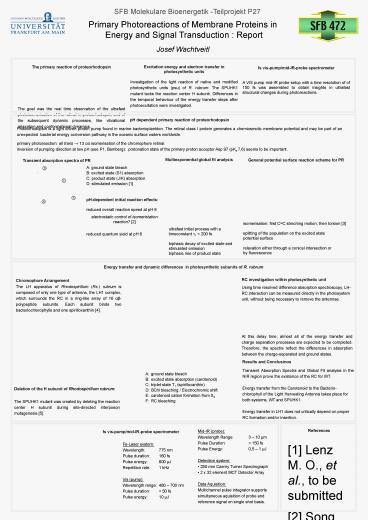PowerPoint-Pr PowerPoint PPT Presentation
Title: PowerPoint-Pr
1
SFB Molekulare Bioenergetik -Teilprojekt P27
Primary Photoreactions of Membrane Proteins in
Energy and Signal Transduction Report
Josef Wachtveitl
Excitation energy and electron transfer in
photosynthetic units Investigation of the light
reaction of native and modified photosynthetic
units (psu) of R. rubrum. The SPUHK1 mutant lacks
the reaction center H subunit. Differences in the
temporal behaviour of the energy transfer steps
after photoexcitation were investigated.
The primary reaction of proteorhodopsin The
goal was the real time observation of the
ultrafast photoisomerisation of the retinal in
proteorhodopsin and of the subsequent dynamic
processes, like vibrational relaxation and
conformational dynamics.
fs vis-pump/mid-IR-probe spectrometer A VIS
pump mid-IR probe setup with a time resolution of
of 150 fs was assembled to obtain insights in
ultrafast structural changes during
photoreactions.
pH dependent primary reaction of
proteorhodopsin Proteorhodopsin is a light
driven proton pump found in marine
bacterioplankton. The retinal class I protein
generates a chemiosmotic membrane potential and
may be part of an unexpected bacterial energy
conversion pathway in the oceanic surface waters
worldwide. primary photoreaction all trans ? 13
cis isomerisation of the chromophore
retinal. inversion of pumping direction at low pH
(see P1, Bamberg) protonation state of the
primary proton acceptor Asp 97 (pKa 7,6) seems to
be important.
Multiexponential global fit analysis
General potential surface reaction scheme for PR
Transient absorption spectra of PR
A ground state bleachB excited state (S1)
absorptionC product state (J/K) absorptionD
stimulated emission 1
pH-dependent initial reaction effectsreduced
overall reaction speed at pH 6 electrostatic
control of isomeristationreaction? 2 reduced
quantum yield at pH 6
isomerisation first CC streching motion, then
torsion 3splitting of the population on the
excited statepotential surfacerelaxation
either through a conical intersection orby
fluorescence
ultrafast initial process with a timeconstant ?1
lt 200 fsbiphasic decay of excited state and
stimulated emissionbiphasic rise of product
state
Energy transfer and dynamic differences in
photosynthetic subunits of R. rubrum
Chromophore Arrangement The LH apparatus of
Rhodospirillum (Rs.) rubrum is composed of only
one type of antenna, the LH1 complex, which
surrounds the RC in a ring-like array of 16
aß-polypeptide subunits. Each subunit binds two
bacteriochlorophylls and one spirilloxanthin 4.
RC investigation within photosynthetic unit Using
time resolved difference absorption spectroscopy,
LH-RC interaction can be measured directly in the
photosystem unit, without being necessary to
remove the antennae.
At this delay time, almost all of the energy
transfer and charge separation processes are
expected to be completed. Therefore, the spectra
reflect the differences in absorption between the
charge-separated and ground states.
Results and Conclusinos Transient Absorption
Spectra and Global Fit analysis in the NIR region
prove the existence of the RC for WT. Energy
transfer from the Carotenoid to the
Bacterio-chlorophyll of the Light Harvesting
Antenna takes place for both systems, WT and
SPUHK1. Energy transfer in LH1 does not
critically depend on proper RC formation and/or
insertion.
A ground state bleach B excited state
absorption (carotenoid) C triplet state T1
(spirilloxanthin) D BChl bleaching /
Electrochromic shift E carotenoid cation
formation from S2 F RC bleaching
Deletion of the H subunit of Rhodospirillum
rubrum The SPUHK1 mutant was created by
deleting the reaction center H subunit during
site-directed interposon mutagenesis 5.
References 1 Lenz M. O., et al., to be
submitted 2 Song L., et al., (1993) Science261,
891-894 3 Garavelli M., et al., (1998) JACS
120, 1285-1288 4 Karrasch R., et al., (1995)
EMBO J. 14, 631638 5 Lupo D.et al., (2004) J.
Bacteriol 186, 5585
- Mid-IR (probe)
- Wavelength Range 3 10 µm
- Pulse Duration lt 150 fs
- Pulse Energy 0,5 1 µJ
- Detection system
- 250 mm Czerny Turner Spectrograph
- 2 x 32 element MCT Detector Array
- Data Aquisition
- Multichannel pulse integrator supports
simultaneous aquisition of probe and reference
signal on single shot basis.
fs vis-pump/mid-IR-probe spectrometer
Fs-Laser system Wavelength 775 nm Pulse
duration 160 fs Pulse energy 800 µJ Repetition
rate 1 kHz Vis (pump) Wavelength range 480
700 nm Pulse duration lt 50 fs Pulse energy 10 µJ

